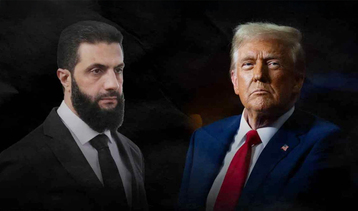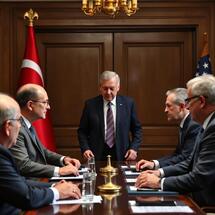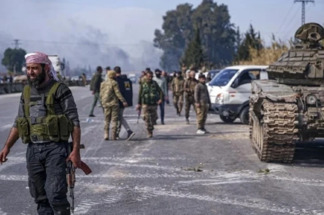-
Walking the Thin Line of CAATSA for Aerial Superiority: The Origins of Egypt’s Su-35 Deal

Is the Su-35 deal worth disturbing 40 years of solid strategic military and diplomatic ties between Cairo and Washington? Will Egypt abandon the Su-35 deal to appease the United States or will it walk the fine line of sanctions to procure superior military capabilities? The answers to all these questions lie in the dramatic shift of Egypt’s military orientation after June 30, 2013.
In October 2013, a few months after the ouster of Egyptian President Morsi’s regime, the U.S. State Department announced the halt of several arms transfers to Egypt, including ten AH-64 Apache helicopters, four F-16C Block 52 fighter jets, M1A1 tank components, and Harpoon anti-ship missiles. The decision was intended to signal U.S. displeasure at human rights violations as a result of Egypt’s military crackdown on the Muslim Brotherhood. It was not until August 2015 that the United States resumed the transfer of military hardware to Egypt.
As a result, beginning in November 2013, the Egyptian military undertook drastic measures to counterbalance their country’s dependence on U.S. military hardware. Toward the end of the year, Egypt began negotiating with Russia for the purchase of MiG-29M2 fighter jets, Ka-52 helicopters and the Antey-2500 anti-ballistic missile system. By 2015, Egypt concluded a deal with France to procure Rafale fighter jets and a FREMM multipurpose frigate. However, the last straw for U.S. officials was Egypt’s $2 billion Su-35 deal in October 2018. For Egypt, the deal represents a chance to procure, for the first time in its history, a new class of fighter aircrafts—a heavyweight class fighter jet.
Fighter jets are classified in three different categories that define their specific roles and capabilities. The first is the light-weight fighter jet, which is designed to satisfy limited-to-standard aerial warfare requirements within a tight combat radius carrying a lesser payload than the two other categories. The medium-weight category comprises fighter jets that are neither short-ranged as the light-weight nor long-ranged as the heavy-weight aircrafts. This grants its operators a balanced fighter jet with a medium combat range and greater payload capacity. Last, but not least, is the heavy-weight fighter jet category, which includes aircraft that are designed to carry heavy weapons and operate at longer ranges than both light and medium-weight fighters. Even though heavy-weight fighters are costly to operate, this is compensated by their aerial capability to accomplish some missions which cannot be undertaken by either the light or medium-weight fighter jets.
Tackling Egypt's Achilles Heel?
A few days after news of the sale broke, then-U.S. Secretary of State Pompeo flagged the deal and warned at a Congressional hearing of imposing (CAATSA) against Egypt. Notwithstanding these possibilities, several members of the Egyptian parliament, including ex-military commanders, warned that these sanctions would be considered unacceptable interference in Egypt’s sovereign decision to procure arms. The deal was justified as part of the country’s efforts to diversify its weapons suppliers. However, for the Egyptian military, the Su-35 represents more than an effort to diversify; it is a chance to address decades of denial of Tier 1 U.S. military aircrafts; a chance to tackle the country’s Achilles heel throughout its modern warfare history—its airpower inferiority when compared to its regional strategic competitors.
 U.S.
U.S.The acquisition of any military hardware is a process guided primarily by rationale linking a country’s perception of its military needs to the means that can effectively and efficiently address those needs. This, however, does not mean that other considerations can be totally ignored or brushed aside. Egypt’s medium-weight F-16 fleet—the backbone of the Egyptian Air Force—is perhaps the world’s most ineffective F-16. Despite upgrading the fleet to Block 40 and 52 standards—by improving the aircraft’s GPS and extending its operational radius by adding conformal fuel tanks—the United States has denied Egypt air-to-air missiles with a range greater than 85 kilometers thereby restricting the country's long/medium air-to-air missile arsenal to the AIM-7 Sparrow intercept missile. The Sparrow is a Cold War relic that requires the operator to remain locked on to the target to score a hit, which denies the pilot freedom of action or maneuverability after launch. On the other hand, U.S. clients in the region—namely Qatar, Bahrain, Saudi Arabia, Israel, Jordan, Oman and Turkey—operate the superior active radar AIM-120 AMRAAM, which has a publicized range that exceeds that of the AIM-7 Sparrow by twenty kilometers and fire-and-forget capability that allows the operator to maneuver freely after launch. These restrictions put Egypt’s entire F-16 fleet at an overwhelming disadvantage should it engage in aerial combat with any air force in the region armed with beyond-visual-range (BVR) missiles. This, in turn, only reinforces Egypt’s principal weakness in past wars: its ineffective air power.
Furthermore, the United States has long denied Egypt advanced heavy air superiority fighters which restricted the range and capability of the Egyptian Air Force. Egypt has repeatedly sought to compensate for these disadvantages since the mid-1970s by pushing for an F-15 heavy-weight fighter deal, but all its requests were rejected to maintain Israel’s qualitative military edge (QME) in the region. For Egypt, this is a particular sour point, as the United States has approved the sale of BVR missiles and heavy-weight fighters to Saudi Arabia and Qatar, countries that are yet to recognize Israel and sign a formal peace deal. In 2018, former U.S. President Donald Trump made a verbal commitment to sell Egypt 20 F-35 fighter jets but, once again, a deal never materialized due to Defense Department opposition and rumored Israeli pressures. This outcome encouraged Egypt to seek advanced fighters from other suppliers even if it would risk CAATSA sanctions.
In July 2019, Moscow delivered four S-400 air defence batteries to Turkey, which raged the United States into expelling Ankara from the F-35 stealth fighter program and imposing sanctions and visa restrictions against personnel associated with the Turkish military procurement agency and industry. In the case of Turkey and the S-400, the United States was well within its right to impose CAATSA sanctions; Turkey, as a NATO ally, gained access to Tier 1 American military hardware including the F-35 fighter program, BVR missiles, THAAD missile defense and MIM-104 Patriot surface-to-air defence batteries. Ergo, its decision to procure alternative Russian systems was not made out of a dire tactical military need but rather was a political stand.
For Egypt, the case is different. It has, for decades, requested Tier 1 American military hardware but was constantly rejected. Even when Egypt requested the Rafale fighter jets, the United States and Israel applied pressure on France to downgrade the air-to-air missiles available to Egypt to the 80 kilometer MICA missile instead of the 100 kilometer Meteor missile.
Many will ask why Egypt needs the advanced air superiority systems and BVR missiles given that it is at peace with Israel and its main threat is Islamic insurgents in the Sinai Peninsula and across the long Libyan borders. This is, however, a reductionist approach, as Egypt faces at least two strategic threats that require boosting its aerial capabilities. The first of these threats is the discovery of a gigantic gas field in the Egyptian Exclusive Economic Zone (EEZ) in the east Mediterranean. Should Egypt wish to effectively secure its EEZ, it needs an effective aerial fleet with a fuel capacity larger than its short-legged F-16 fighters to support its naval units operating in the region. Second is the threat posed to its south by the Grand Ethiopian Renaissance Dam (GERD). Negotiations over the dam’s operation and regulation have not yet led to any legally binding agreement between Egypt, Sudan and Ethiopia. Should tensions between the three countries devolve into armed conflict, Egypt would need to operate an aerial fleet with a BVR capability to counter the Ethiopian Su-27 Flanker air superiority fleet, which is armed with R-27 air-to-air missiles whose range exceeds that of the Egyptian AIM-7 Sparrow and MICA missiles.
For these reasons, the Su-35 deal is a bitter pill Egypt has opted to swallow to remedy its aerial inferiority. Egypt recognizes that it will face several challenges when it comes to integrating the Su-35 into its air force fleet. It is not possible for the U.S.-made aircraft, which constitute the backbone of the Egyptian Air Force and Egypt’s U.S.-made early warning systems—namely the E2 Hawkeye and C-130-H equipped with Roll-on/Roll-off Electronic Intelligence systems, to exchange data and communication with Russian-made systems. These challenges will effectively make Egypt’s heavy-weight Su-35s and medium-weight MIG-29M2 an air force within an air force that operates almost autonomously and flies blindly. Egypt attempted to tackle this challenge by launching an indigenous Radar Integration and Surveillance Command Center—RISC2—that allows aircraft of mixed origins to exchange data via a unified platform. However, the operational status of this system is still questionable, and its combat effectiveness has yet to be tested. Knowing of these challenges and yet proceeding with the Su-35 deal means only one thing for Egypt—it is willing to swallow a bitter pill and risk operating a hybrid fleet in order to acquire aircraft that can extend its aerial combat radius and deliver a large payload over longer ranges, thereby increasing the capabilities of its air force.
The United States can, however, encourage Egypt to reconsider the Su-35 deal if it is willing to offer suitable alternatives that meet the Egyptian Air Force’s requirements. Some of these alternatives need not be the advanced F-35 fighter jet, but can include the export of similar systems and ammunition previously sold to Saudi Arabia and Qatar, such as the AIM-120 AMRAAM active radar and the heavy-weight F-15 fighters. Additionally, the threat of imposing sanctions on Egypt might drastically impact U.S. relations with the Egyptian military, which could lead to the reorientation of Egyptian military leadership to Eastern military educational institutions after decades of investing in a U.S.-educated Egyptian officer corps. Furthermore, linking matters of political differences, such as human rights, democracy and good governance to cooperation with the Egyptian military institution has not worked and has only increased tensions. A limited, pragmatic approach is more likely to enable the United States to advance its interests in Egypt in an era of renewed Great Power competition. Nevertheless, should Egypt receive no suitable alternative hardware from the United States, it might find itself in a position risking CAATSA for greater aerial capabilities as the only means to tackle its aerial incapacity.
The Spanish Philosopher George Santayana once said, “those who forget their history are condemned to repeat it.” The U.S. denial of Tier 1 military hardware exports to Egypt, a strategic partner and ally, is a continuation of ignoring a valuable historic lesson, and is a continuation of an unfortunate U.S. policy that once contributed to destabilizing the Middle East in the 1950s. When the U.S. denied Egypt the export of then-advanced military hardware in 1954, namely fighter jets and tanks, Egypt found itself coerced to arm itself from other competitors such as the Soviet Union in what later came to be known as the Czech Arms Deal. Decades later, it has been proven that Egypt’s shift to the East for arms was a key factor that fed the Egyptian-Israeli conflict; a conflict that only ceased to exist after Egypt’s shift to the U.S. camp after 1979. Should the U.S. revise its arms export restrictions to Egypt, it will restore faith in the strong U.S.-Egyptian strategic partnership and much needed regional cooperation.
by: Karim E. El-Baz
The Levant News
You May Also Like
Popular Posts
Caricature
BENEFIT Sponsors BuildHer...
- April 23, 2025
BENEFIT, the Kingdom’s innovator and leading company in Fintech and electronic financial transactions service, has sponsored the BuildHer CityHack 2025 Hackathon, a two-day event spearheaded by the College of Engineering and Technology at the Royal University for Women (RUW).
Aimed at secondary school students, the event brought together a distinguished group of academic professionals and technology experts to mentor and inspire young participants.
More than 100 high school students from across the Kingdom of Bahrain took part in the hackathon, which featured an intensive programme of training workshops and hands-on sessions. These activities were tailored to enhance participants’ critical thinking, collaborative problem-solving, and team-building capabilities, while also encouraging the development of practical and sustainable solutions to contemporary challenges using modern technological tools.
BENEFIT’s Chief Executive Mr. Abdulwahed AlJanahi, commented: “Our support for this educational hackathon reflects our long-term strategic vision to nurture the talents of emerging national youth and empower the next generation of accomplished female leaders in technology. By fostering creativity and innovation, we aim to contribute meaningfully to Bahrain’s comprehensive development goals and align with the aspirations outlined in the Kingdom’s Vision 2030—an ambition in which BENEFIT plays a central role.”
Professor Riyadh Yousif Hamzah, President of the Royal University for Women, commented: “This initiative reflects our commitment to advancing women in STEM fields. We're cultivating a generation of creative, solution-driven female leaders who will drive national development. Our partnership with BENEFIT exemplifies the powerful synergy between academia and private sector in supporting educational innovation.”
Hanan Abdulla Hasan, Senior Manager, PR & Communication at BENEFIT, said: “We are honoured to collaborate with RUW in supporting this remarkable technology-focused event. It highlights our commitment to social responsibility, and our ongoing efforts to enhance the digital and innovation capabilities of young Bahraini women and foster their ability to harness technological tools in the service of a smarter, more sustainable future.”
For his part, Dr. Humam ElAgha, Acting Dean of the College of Engineering and Technology at the University, said: “BuildHer CityHack 2025 embodies our hands-on approach to education. By tackling real-world problems through creative thinking and sustainable solutions, we're preparing women to thrive in the knowledge economy – a cornerstone of the University's vision.”
opinion
Report
ads
Newsletter
Subscribe to our mailing list to get the new updates!





















